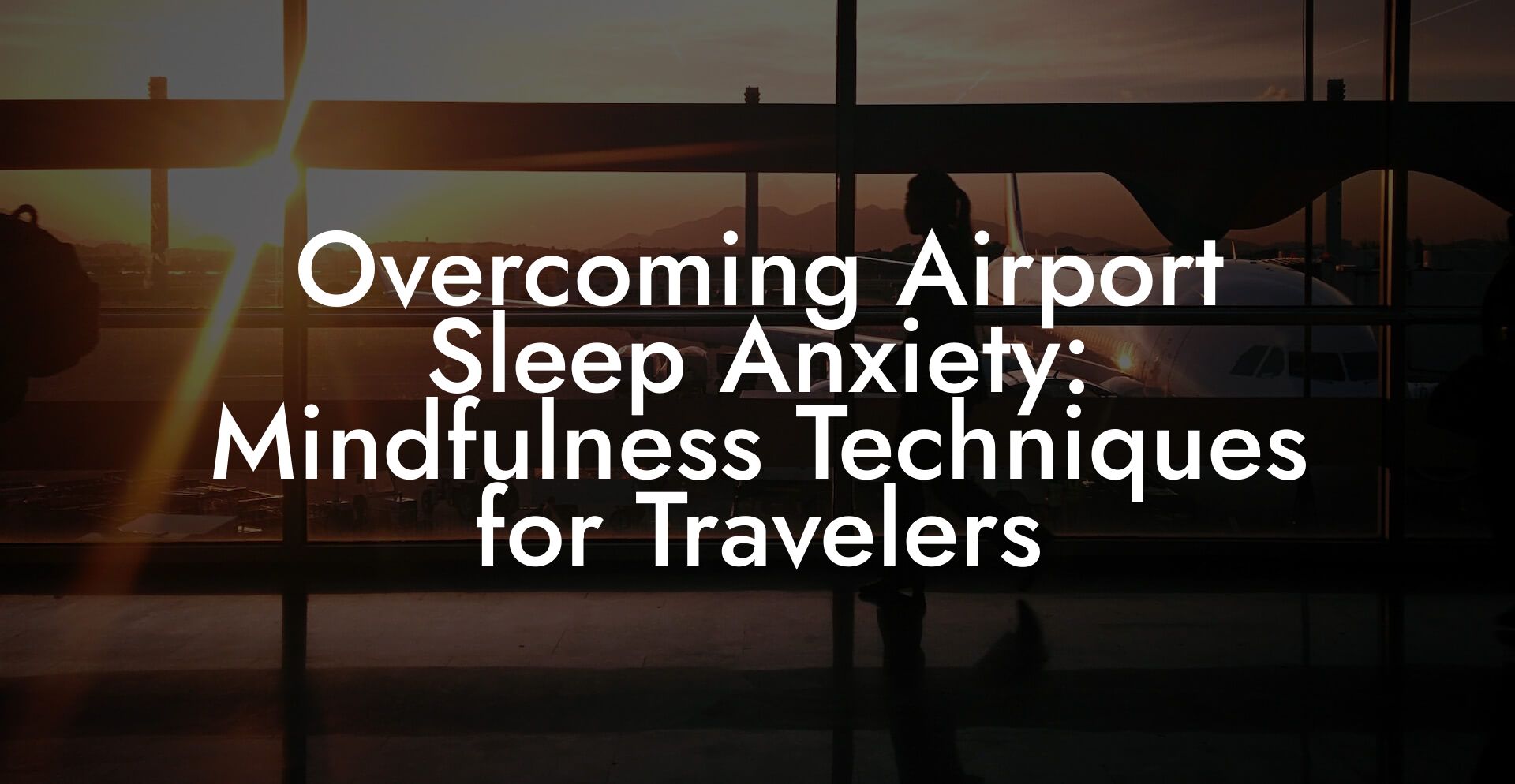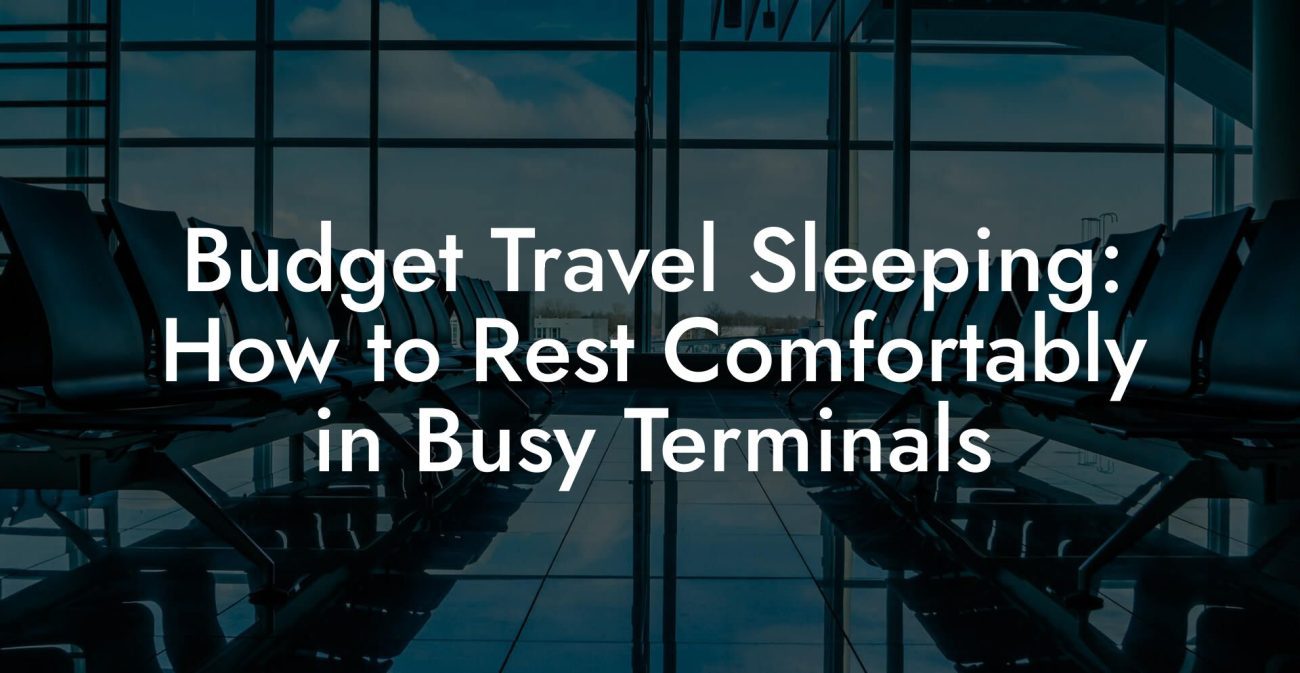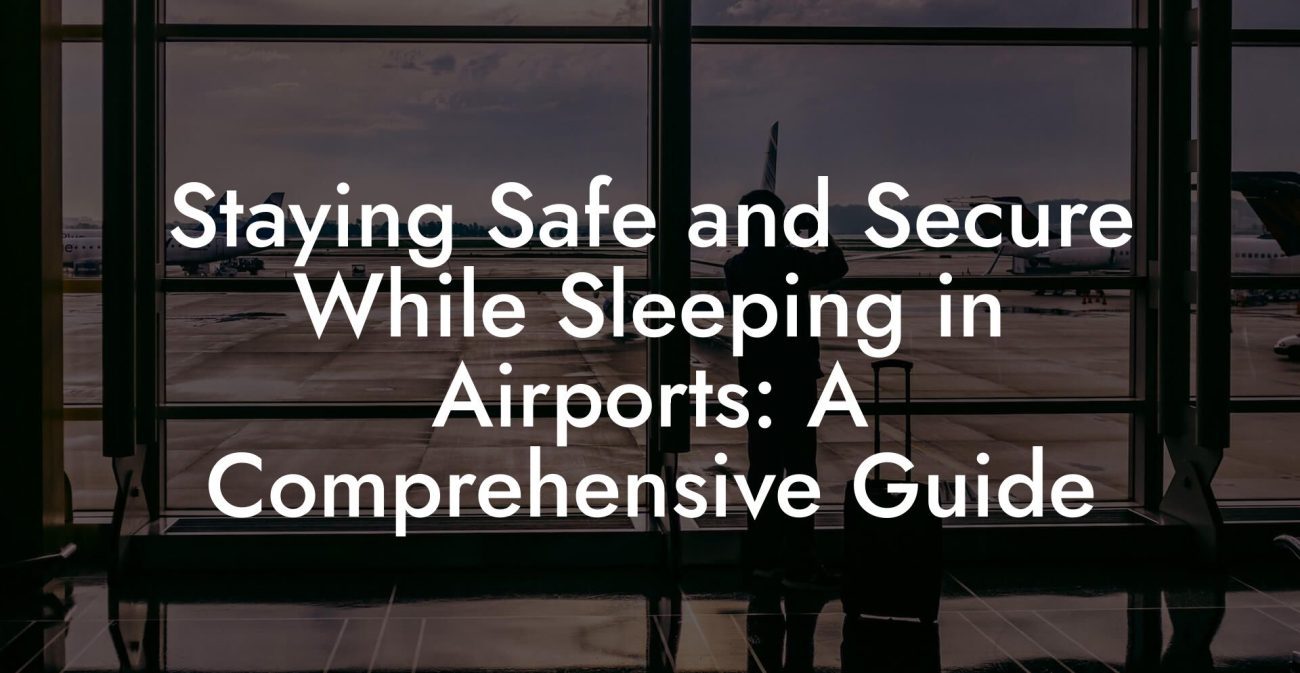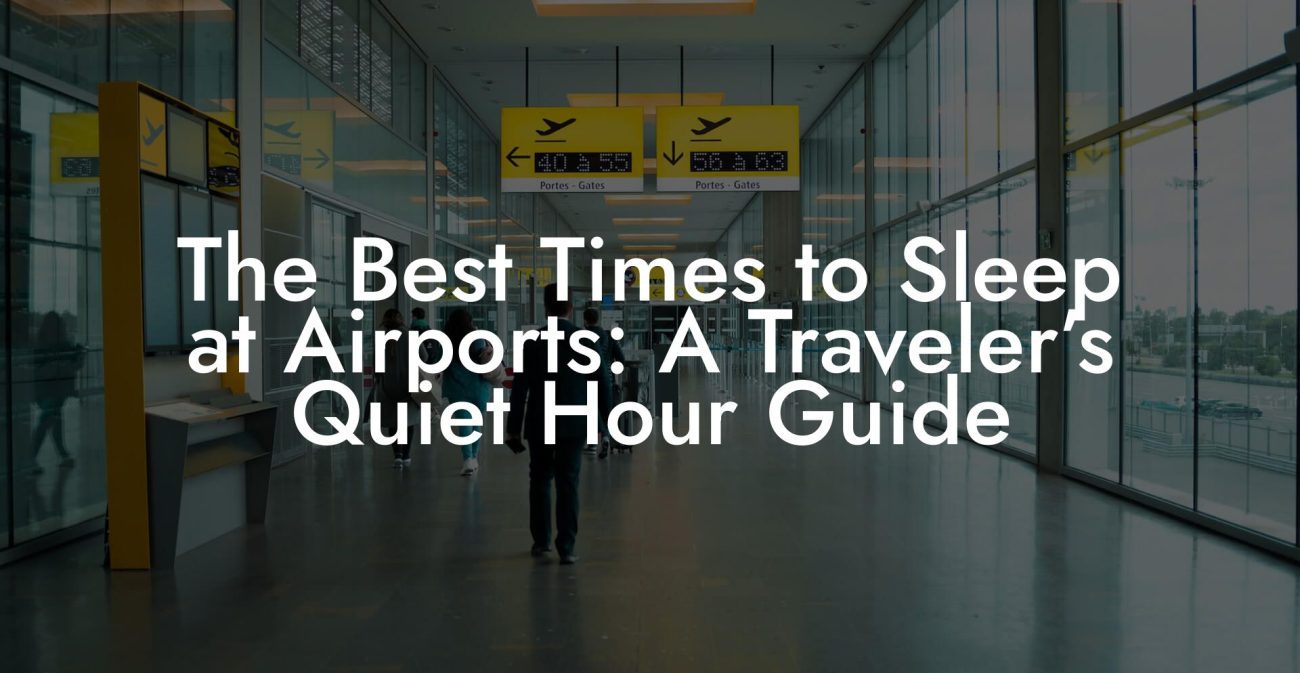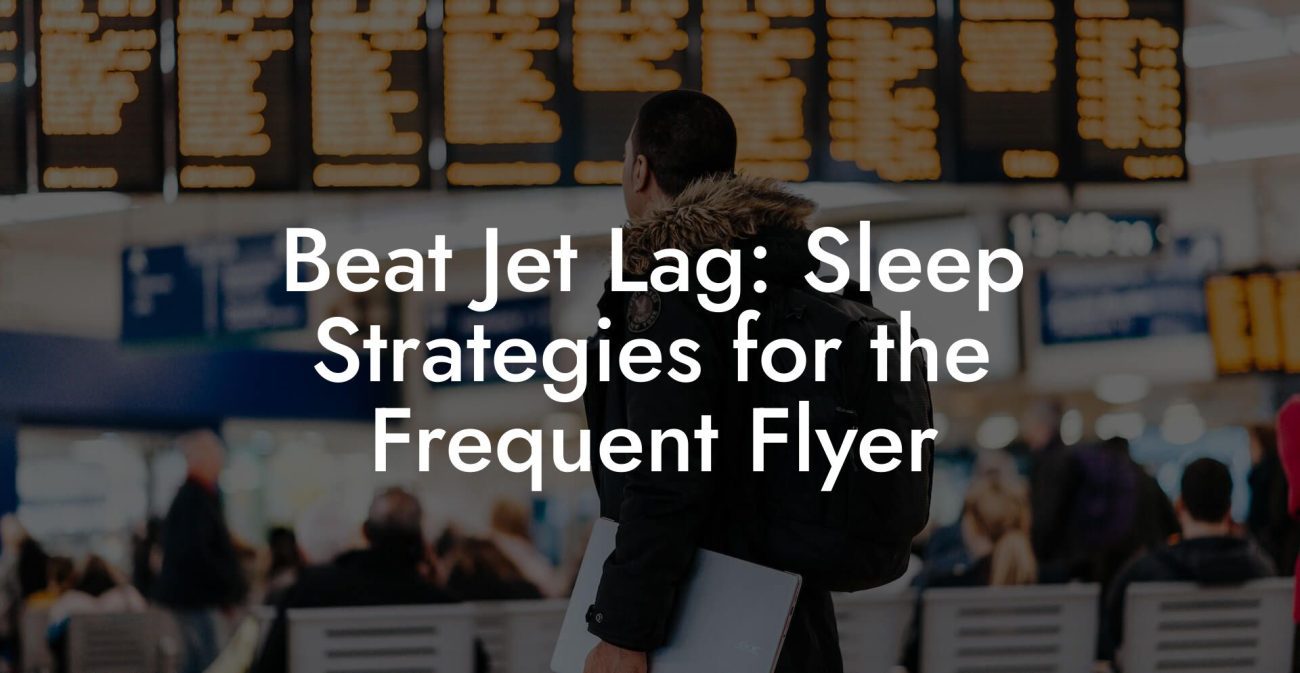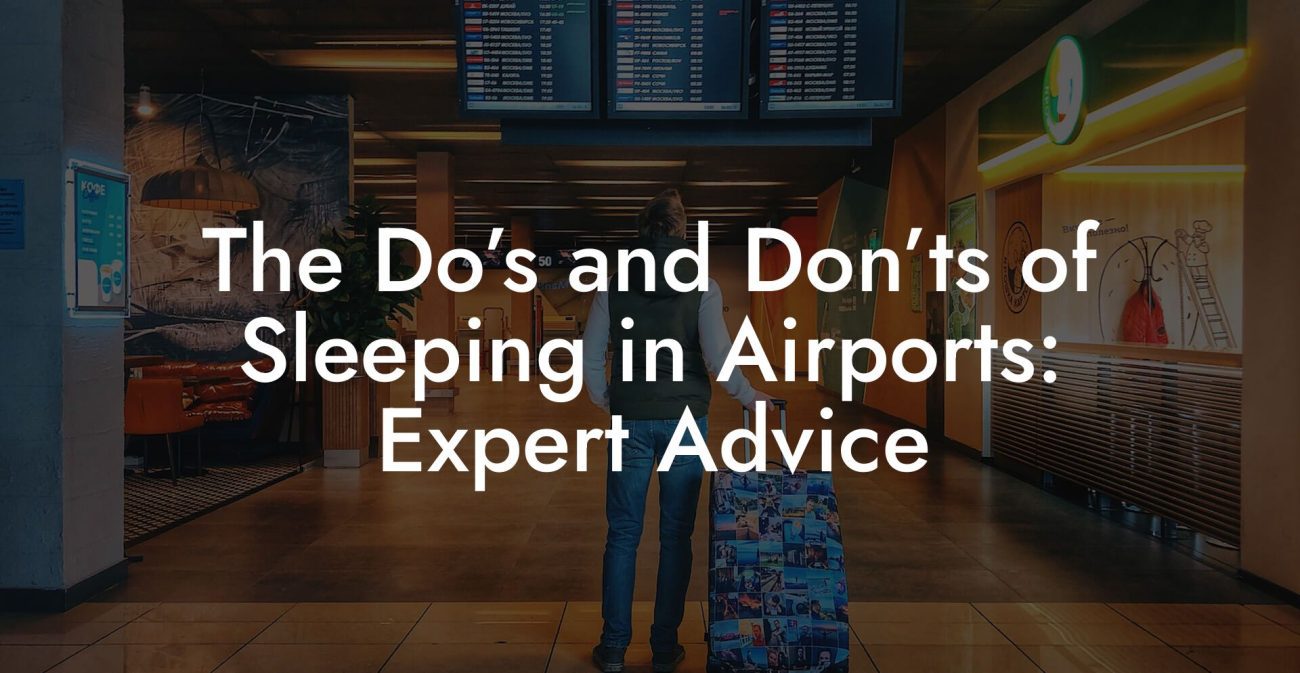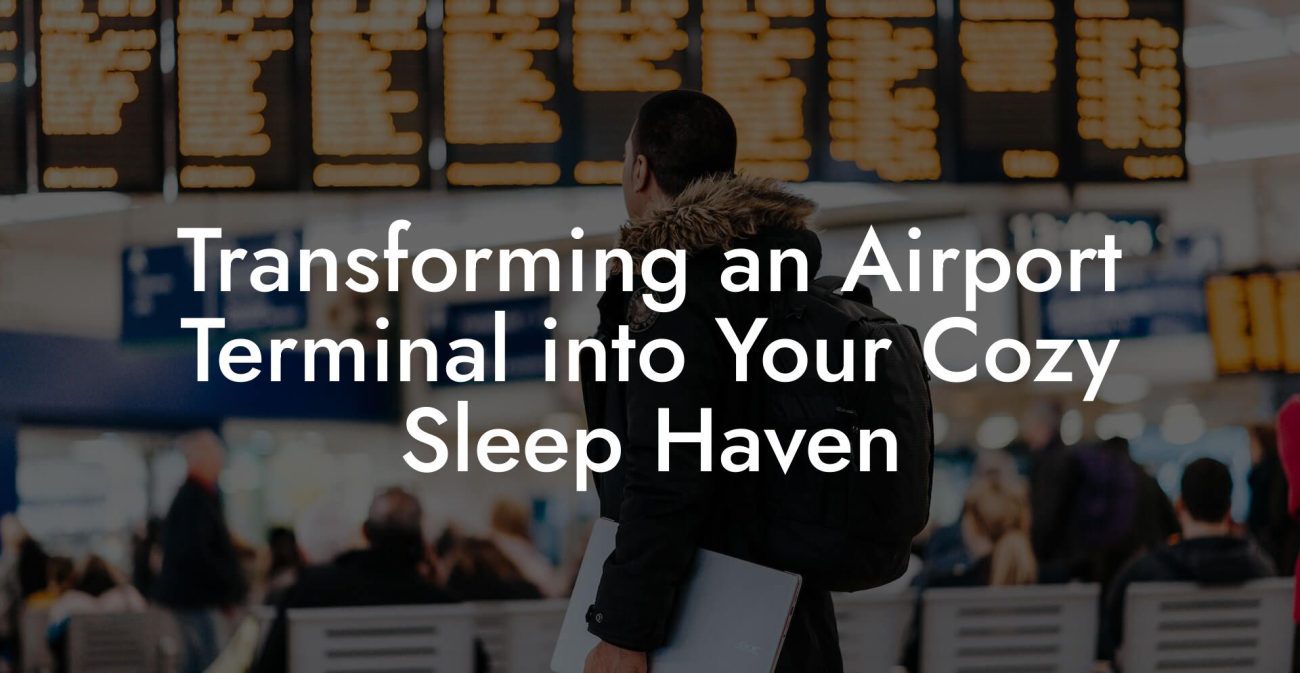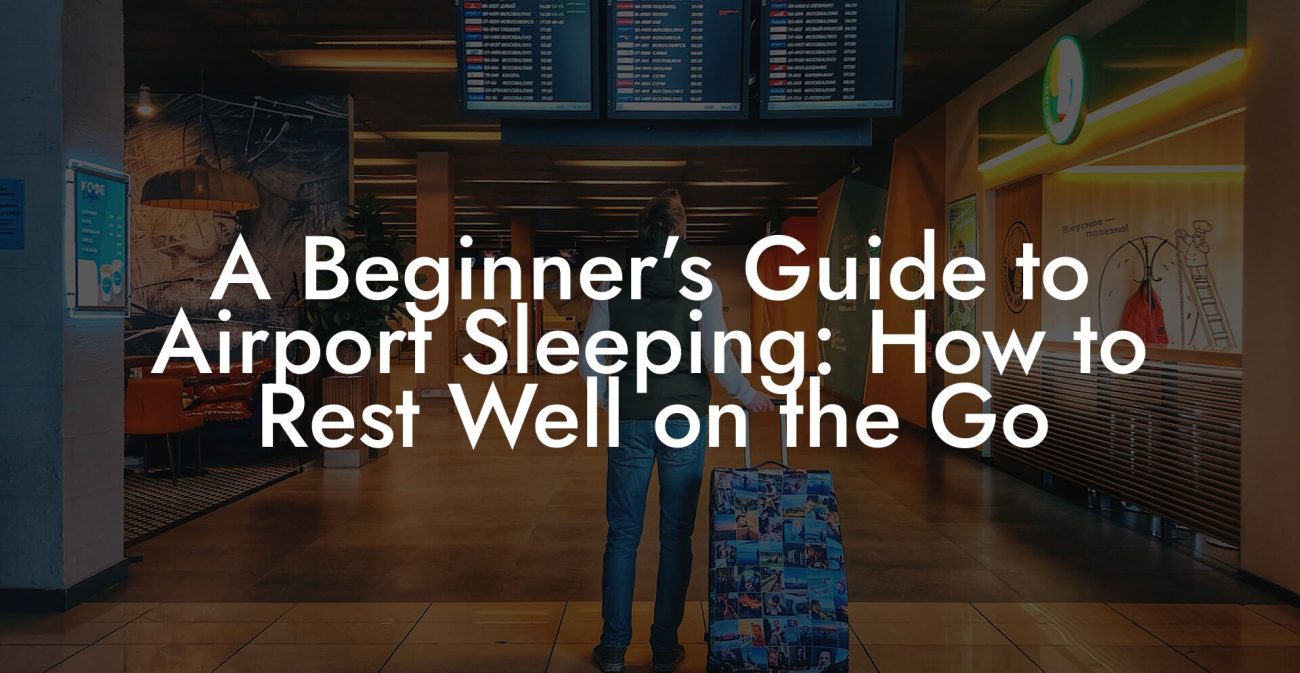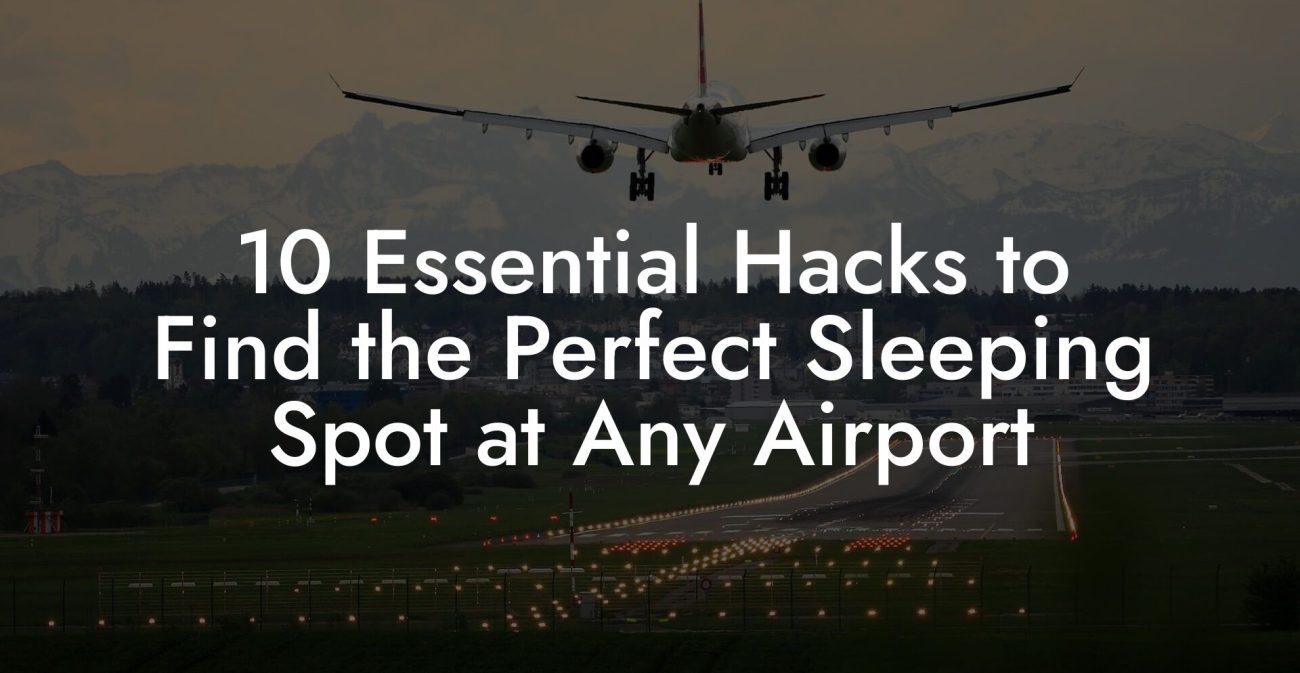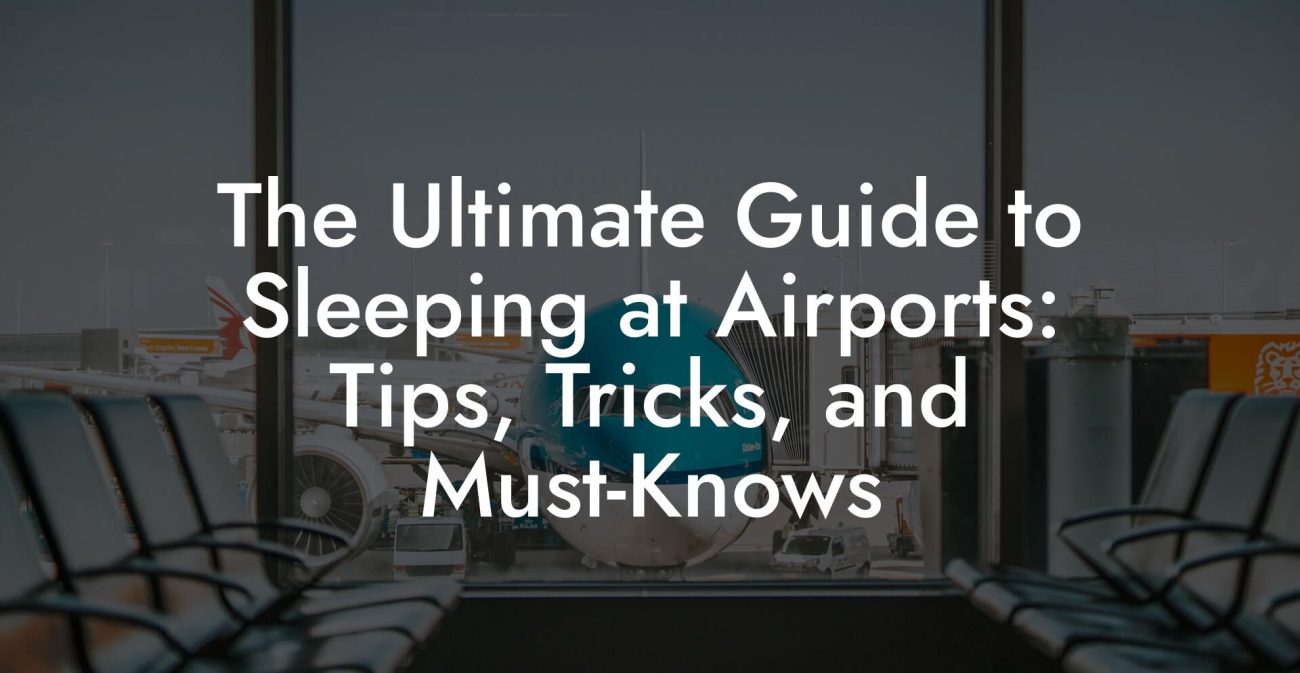Ever found yourself pacing an endless terminal, heart pounding as the departure board flickers like a horror movie countdown, and sleep seems like a long-forgotten luxury? You’re not alone. Airport sleep anxiety is a real phenomenon that turns even the most seasoned traveler into a jittery insomniac. But what if you could hit the pause button on stress with mindfulness techniques, easing your way into a blissful slumber—even in bustling terminals and cramped sleeping pods? Let’s dive headfirst into a world where jet lag meets zen, and mindfulness becomes your in-flight companion.
Quick Links to Useful Sections
- Understanding Airport Sleep Anxiety
- Common Causes of Sleep Anxiety at Airports
- Mindfulness Techniques for Tackling Airport Sleep Anxiety
- 1. Controlled Breathing Exercises
- 2. Progressive Muscle Relaxation
- 3. Guided Meditation and Sleep Apps
- 4. Visualization Techniques
- 5. Mindful Journaling
- The Science Behind Mindfulness and Sleep
- Tech-Savvy Sleep Hacks: The Role of Airport Sleeping Pods
- Practical Tips for a Mindful Airport Sleep Routine
- Plan Ahead
- Create a Pre-Sleep Ritual
- Invest in Travel Comfort Accessories
- Reserve Your Pod in Advance
- Stay Hydrated and Avoid Caffeine Late in Your Terminal Time
- In-Flight Mindfulness: Techniques That Carry Over
- Seated Meditation and Breathing
- Stretching and Movement
- Digital Detox
- Comfort Check
- Navigating the Obstacles: When Mindfulness Meets Reality
- Real-Life Experiences: Travelers Who Beat Airport Sleep Anxiety
- Alex’s Journey to Terminal Zen
- Jamie’s Secret Weapon: The Airport Sleeping Pod
- Practical Steps to Build Your Airport Mindfulness Routine
- Step 1: Prepare Before Departure
- Step 2: Set an Intention for Your Journey
- Step 3: Create a Terminal Routine
- Step 4: Embrace Flexibility
- Step 5: Reflect and Adjust
- Resources and Community Support: Your Next Steps
- Mindfulness Meets Travel Technology: The Future of Airport Sleep
- Case Studies: Travelers Who Overcame Airport Sleep Anxiety
- The Night Owl Turned Mindfulness Maven
- The Jet-Setting Blogger’s Guide to Sleep Pods
- The Millennial Nomad’s Stress-Busting Strategy
- Building Your Personalized Mindfulness Travel Plan
- Step 1: Self-Assessment
- Step 2: Define Your Goals
- Step 3: Gather Your Tools
- Step 4: Create a Routine
- Step 5: Evaluate and Adapt
- FAQs: Overcoming Airport Sleep Anxiety and the Power of Mindfulness
- Embark on Your Zen-Fueled Journey: A New Era of Travel Sleep
Understanding Airport Sleep Anxiety
Before we board this flight to tranquility, it’s essential to understand what airport sleep anxiety actually is. More than just a case of the pre-flight jitters, it’s the overwhelming feeling of unease and restlessness many travelers experience when trying to sleep in public spaces. The constant hum of conversations, neon-lit terminals, and the stress of catching that next tight connection can make it nearly impossible to get any decent shut-eye.
For Gen-Z and millennials, who often juggle hectic schedules, side hustles, and digital distractions, airport sleep anxiety can feel like yet another challenge in the chaotic world of travel. Whether you’re waiting for a red-eye flight or embarking on that epic weekend adventure, the struggle for quality airport sleep is all too real.
Common Causes of Sleep Anxiety at Airports
The causes of airport sleep anxiety are as varied as the destinations on your boarding pass. Let’s break down the usual suspects:
- Noise Overload: The soundscape is a mix of rolling suitcases, intercom announcements, and caffeine-fueled conversations. This cacophony can be a nightmare for anyone trying to drift off.
- Unpredictable Environments: Constant changes in lighting, temperature, and seating arrangements can disrupt your body’s natural sleep cues.
- High-Stress Situations: Tight connections, flight delays, and general travel stress can spike anxiety hormones, making it difficult to relax.
- Overstimulation from Gadgets: With endless scrolling on your phone, the blue light effects mess up your circadian rhythm before you even think about catching some Z’s.
Recognizing these triggers is step one. With that awareness, you can start tailoring mindfulness techniques to your unique airport sleep challenges.
Mindfulness Techniques for Tackling Airport Sleep Anxiety
Enter mindfulness—a powerful, well-researched tool that can help transform your chaotic airport experience into a moment of calm solitude. Here are some mindfulness techniques designed to ease your mind, quiet your thoughts, and prepare your body for sleep, even in the hustle and bustle of an airport.
1. Controlled Breathing Exercises
Nothing resets your stress response quite like controlled breathing. Try the 4-7-8 technique: breathe in through your nose for 4 seconds, hold for 7 seconds, and slowly exhale through your mouth for 8 seconds. Repeat a few times and feel your body relax with every exhale.
2. Progressive Muscle Relaxation
Progressive muscle relaxation (PMR) involves tensing and then slowly relaxing each muscle group in your body. While seated in that less-than-comfortable airport chair, start from your toes and work your way up. This practice not only distracts you from noisy surroundings but also resets your internal tension.
3. Guided Meditation and Sleep Apps
In the age of technology, your smartphone is not just a portal to memes and TikTok—it can also be your personal meditation coach. Apps like Calm, Headspace, and Insight Timer offer guided meditations specifically designed to soothe travel anxiety and promote sleep. Plug in your earphones, dim the screen brightness, and let a calm voice help you visualize a serene beach far away from the clamor of boarding gates.
4. Visualization Techniques
Picture yourself in a haven where the only sounds are the gentle lapping of waves or rustling leaves in a quiet forest. This mental imagery can help create a stark contrast to your environment, giving your mind a break from the chaos outside.
5. Mindful Journaling
Writing down your thoughts and anxieties can be a cathartic experience. In your pre-flight routine, consider keeping a small, portable journal. By putting your racing thoughts on paper, you activate a mindful break that turns worry into a manageable to-do list for later.
The Science Behind Mindfulness and Sleep
It might sound a bit woo-woo, but mindfulness has a strong backing in scientific research. Studies have shown that mindfulness practices not only lower stress hormones like cortisol but also enhance sleep quality by reducing the hyperarousal that often accompanies anxiety in unfamiliar environments.
When you engage in mindfulness meditation or controlled breathing, your body shifts into what scientists call the parasympathetic state—the “rest and digest” mode. This biological switch naturally calms your heart rate, soothes your nervous system, and prepares you for rest. So next time you’re fighting off airport sleep anxiety, remember that your mind is a powerful tool that can change your body’s response to stress.
With the brain and body on board, integrating mindfulness into your travel routine is less about escaping the chaos and more about finding peace amidst the storm.
Tech-Savvy Sleep Hacks: The Role of Airport Sleeping Pods
Let’s be real—sometimes your personal mindfulness routine meets its match in the form of an uncomfortable airport bench. Enter airport sleeping pods, the ultimate in travel tech that has redefined the way we take power naps on the go.
Airport sleeping pods are designed with a solid focus on comfort and privacy. Here’s a snapshot of their benefits:
- Privacy and Isolation: These pods create a quiet and semi-enclosed space that minimizes external distractions.
- Built-In Amenities: From adjustable lighting to charging ports, many pods come equipped with the essentials to get your beauty sleep on.
- Comfortable Bedding: Plush mattresses and ergonomic designs make these pods a far cry from your typical airport seating.
But while sleeping pods can significantly improve your ability to nap, they’re only half the solution. Incorporating mindfulness techniques before, during, and after your pod experience can help deepen your relaxation, ensuring that your body and mind transition seamlessly into sleep mode.
Whether you’re a digital nomad or a frequent flyer with a penchant for snoozing in unconventional places, combining tech with mindful practices can dramatically improve your airport sleep quality.
Practical Tips for a Mindful Airport Sleep Routine
Integrating mindfulness into your travel routine might sound challenging, but with a few practical steps, you can transform even a chaotic terminal into your personal oasis of calm:
Plan Ahead
Before your trip, research the airport layout to locate quiet zones, sleeping pods, or even lounges that offer a more comfortable environment for rest. Knowing your options means you can plan a stopover that’s conducive to mindfulness and relaxation.
Create a Pre-Sleep Ritual
Design a short routine that signals your body, “Hey, it’s time to chill!” This could include dimming your phone screen, putting on calming music or a meditation podcast, and performing a few deep-breathing exercises. Over time, your brain will associate these cues with sleep, making it easier to transition into rest even in a noisy airport.
Invest in Travel Comfort Accessories
A good quality noise-canceling headset, an eye mask, and a travel pillow can make a world of difference. These tools help create a personal cocoon where mindfulness can thrive, undisturbed by the clamor around you.
Reserve Your Pod in Advance
If your airport offers sleeping pods, try to reserve one ahead of time. A guaranteed spot can alleviate part of the anxiety associated with last-minute scrambling. Plus, having a designated sleep zone can be a powerful anchor for your mindfulness practice.
Stay Hydrated and Avoid Caffeine Late in Your Terminal Time
While that triple espresso might seem like a travel essential, it can keep your mind racing when you really need to wind down. Opt for water or herbal teas that support relaxation and balance your body’s natural rhythms.
In-Flight Mindfulness: Techniques That Carry Over
The benefits of mindfulness don’t disappear once you step out of the terminal—they can follow you right into your flight. Here’s how you can continue your mindfulness practice in the air:
Seated Meditation and Breathing
Use your seat as a mini meditation zone. Close your eyes, tuck in your head against the headrest, and practice slow, mindful breathing. This simple act can reduce stress and even improve your in-flight sleep quality.
Stretching and Movement
Take regular breaks to stand up and stretch during long flights. Simple movements not only ease physical tension but also give your mind a chance to breathe and reset.
Digital Detox
Resist the urge to scroll through social media. Instead, consider listening to an audiobook or a guided meditation track that encourages relaxation. Lowering your screen time gives your brain a break from the relentless stimulation.
Comfort Check
Ensure that you’re as comfortable as possible by adjusting your seat, using your travel pillow, and dimming the overhead lights. A small investment in comfort can lead to a big payoff in sleep quality mid-flight.
Navigating the Obstacles: When Mindfulness Meets Reality
Let’s be real—sometimes no amount of breathing exercises can drown out that incessant announcement over the PA system. During these moments, remember that it’s okay to feel frustrated. Instead of fighting the noise, acknowledge it and let it pass. Embrace the imperfection of your environment, and view it as part of your unique travel adventure.
Mindfulness isn’t about achieving perfection; it’s about accepting reality as it is, finding small moments of serenity amid the chaos, and learning that even a little bit of zen can go a long way in transforming your travel experience.
And if all else fails, a bit of humor goes a long way. Smile at the absurdity of trying to sleep in a bustling terminal, laugh at the quirky airport art, and remember that these unpredictable travel moments often make for the best stories later on.
Real-Life Experiences: Travelers Who Beat Airport Sleep Anxiety
There’s nothing quite as inspiring as hearing from fellow travelers who have successfully navigated the challenge of airport sleep anxiety. Meet Alex, a digital nomad who turned terminal turbulence into a mindful meditation session, and Jamie, a millennial globetrotter who swears by their trusty sleep pod and a killer set of breathing exercises.
Alex’s Journey to Terminal Zen
Alex used to dread layovers. Pacing the terminal, feeling anxious about missed connections, and being bombarded by flashing screens made him a magnet for sleep anxiety. Once he discovered mindfulness techniques—especially controlled breathing and guided meditation—he transformed his waiting time into moments of calm. Today, Alex logs off (at least mentally) by diving into his meditation app and often finds himself enjoying a refreshing power nap in a cozy airport nook.
Jamie’s Secret Weapon: The Airport Sleeping Pod
Jamie’s travel story involved multiple missed connections and restless nights until she discovered the magic of airport sleeping pods. Combining the comfort of a dedicated sleeping space with her newfound love for progressive muscle relaxation, she turned her travel anxiety into a well-rehearsed routine. With her noise-canceling headphones, eye mask, and a backup meditation playlist, Jamie now relishes every layover as an opportunity to recharge—both physically and mentally.
Practical Steps to Build Your Airport Mindfulness Routine
Ready to transform your travel anxiety into a slice of mindful bliss? Here’s a step-by-step guide to help you build a personalized routine suited to your travel style:
Step 1: Prepare Before Departure
A little pre-planning goes a long way. Start by researching your airport’s amenities—find out if they offer sleeping pods, quiet zones, or relaxation lounges. Pack a small travel kit with noise-canceling headphones, an eye mask, a travel pillow, and your favorite meditation app ready to go.
Step 2: Set an Intention for Your Journey
Before you even step into the terminal, set a simple intention: “I deserve peace, even in transit.” This short declaration can refocus your mindset and prepare your brain to prioritize relaxation over stress.
Step 3: Create a Terminal Routine
Develop a mini routine that you follow each time you’re in an airport. This could start with a short guided meditation, followed by a few rounds of deep breathing, and then a gentle stretch or mindful walk. Find that sweet spot where you can retreat into a pocket of calm amidst the bustling terminal.
Step 4: Embrace Flexibility
Not every terminal will be as accommodating as your favorite hangout spot. Learn to adapt your routine to the space you have—whether that means meditating in a quiet corner of the gate area or using your travel accessories to create a makeshift sleep pod.
Step 5: Reflect and Adjust
After each journey, spend a few minutes reflecting on what worked and what didn’t. Over time, you’ll learn which techniques are your golden tickets to calm, allowing you to fine-tune your routine and conquer airport sleep anxiety with confidence.
Resources and Community Support: Your Next Steps
Embarking on a mindfulness journey in travel can feel daunting, but you’re not alone. There’s a vibrant community of seasoned travelers, digital nomads, and mindful explorers who are all navigating airport sleep anxiety. Consider joining travel forums, social media groups, or local meetups centered on wellness and mindful travel. Exchanging tips, personal hacks, and even a few laugh-out-loud travel mishaps can help you feel connected and supported.
Explore online resources like travel blogs, YouTube channels, and podcasts dedicated to mindful living on the go. Many of these platforms regularly feature expert advice on airport comfort, the latest in sleep technology, and innovative mindfulness techniques specifically tailored for travelers.
Remember, every successful traveler started somewhere. By embracing mindfulness techniques and tapping into community wisdom, you’re taking the first step towards transforming airport anxiety into an opportunity for growth, relaxation, and maybe even a bit of well-deserved rest.
Mindfulness Meets Travel Technology: The Future of Airport Sleep
The intersection of mindfulness, technology, and travel is evolving at lightning speed. Imagine a future where your wearable devices not only track your sleep but also suggest real-time mindfulness practices based on your stress levels. Already, smart apps are integrating guided meditations with data from your fitness tracker, giving you a personalized mindfulness routine on the go.
The convergence of sleep technology and mindful practices isn’t just a futuristic fantasy—it’s happening now. From high-tech sleeping pods to meditation apps with soothing soundscapes, the tools are at your fingertips to help you master airport sleep anxiety. Embracing these innovations means you’re not only catching up on sleep, but you’re also setting the stage for a healthier, more balanced travel lifestyle.
Case Studies: Travelers Who Overcame Airport Sleep Anxiety
Real-life examples of travelers overcoming airport sleep anxiety can be incredibly motivating. Here are a few inspiring stories to remind you that achieving restful sleep in the midst of travel chaos is possible:
The Night Owl Turned Mindfulness Maven
Taylor, a self-proclaimed night owl and frequent flyer, used to spend layovers fiddling with apps and scrolling through news feeds, which only worsened their sleep anxiety. Once Taylor discovered the power of progressive muscle relaxation and meditation, they saw an immediate improvement. Taylor now follows a strict pre-nap routine that includes breathing exercises and visualizations, turning even the busiest terminals into havens of calm.
The Jet-Setting Blogger’s Guide to Sleep Pods
Sam, an intrepid travel blogger, realized early on that airport sleeping pods were a game changer. Combining the convenience of personal sleep pods with a curated list of mindfulness practices, Sam began to document every step of their journey toward better travel sleep. Their blog is now a go-to resource for fellow wanderers looking for productivity tips, mindfulness hacks, and the best airport pods across the globe.
The Millennial Nomad’s Stress-Busting Strategy
Olivia, a millennial digital nomad, struggled with severe sleep anxiety that affected her work and travel schedule. After attending a mindfulness workshop and integrating several techniques—like guided meditation and controlled breathing—into her daily routine, Olivia saw drastic improvements. Now, she credits her newfound ability to catch quality rest at airports with boosting her overall creativity and productivity.
Building Your Personalized Mindfulness Travel Plan
Crafting a comprehensive plan to overcome airport sleep anxiety is like planning a well-curated itinerary—detailed, flexible, and tailored to your unique travel needs. Here’s how you can build a plan that works:
Step 1: Self-Assessment
Start by assessing your typical travel patterns and stress triggers. Does the noise keep you up? Is it the seating discomfort, or maybe the relentless screen time? Identifying these factors can help you select the right mindfulness techniques.
Step 2: Define Your Goals
What does a good sleep experience look like for you? Whether it’s feeling recharged after a power nap or maintaining your mental clarity during long layovers, setting clear intentions will keep your plan focused.
Step 3: Gather Your Tools
Equip yourself with the essentials—a reliable meditation app, a pair of noise-canceling headphones, an eye mask, and a travel pillow. If your airport offers sleeping pods, be sure to book one in advance. This kit is your travel survival pack for moments when sleep anxiety rears its head.
Step 4: Create a Routine
Design a simple yet effective routine that you can follow every time you’re at the airport. Include a few minutes of deep breathing, some light stretching, or even a short nap in a pod. Consistency is key when it comes to reprogramming your body for relaxation.
Step 5: Evaluate and Adapt
After each trip, take a moment to reflect on what worked and what didn’t. Keep a small travel journal where you note your experiences, any anxiety triggers, and how effective your mindfulness practices were. Over time, you can fine-tune your routine for maximum relaxation.
FAQs: Overcoming Airport Sleep Anxiety and the Power of Mindfulness
Here are some frequently asked questions that can help guide you on your journey to mastering airport sleep anxiety with mindfulness techniques:
1. What exactly is airport sleep anxiety?
Airport sleep anxiety is the overwhelming unease and stress that many travelers experience when trying to sleep in the unpredictable environment of an airport. It stems from noise, unfamiliar surroundings, and the constant pressure of catching flights.
2. How can mindfulness help me sleep in an airport?
Mindfulness techniques, such as controlled breathing, guided meditation, and progressive muscle relaxation, help lower stress hormones and create a calm mental state that promotes better sleep—even in hectic, noisy settings.
3. Are airport sleeping pods really worth it?
Absolutely. Sleeping pods offer a private, quieter space with additional amenities that make it easier to fall asleep, especially when combined with mindfulness practices.
4. What are some quick mindfulness exercises I can do at the gate?
Simple techniques include the 4-7-8 breathing exercise, a short guided meditation from your favorite sleep app, or even a quick session of progressive muscle relaxation to release built-up tension.
5. Can these techniques really improve my overall travel experience?
Yes! Overcoming sleep anxiety not only improves your sleep quality but also enhances your mood, concentration, and overall travel experience, making you a more relaxed and confident traveler.
6. How do I choose the right mindfulness app?
Look for apps that offer guided meditations designed for stress relief and sleep improvement, such as Calm, Headspace, or Insight Timer. Many of these apps have sessions specifically tailored for travelers.
7. Can I practice these mindfulness techniques even if I’m not a natural meditator?
Absolutely. Mindfulness is a skill that can be developed over time—not everyone is a natural meditator, but with consistent practice, you can reap significant benefits.
8. Should I combine mindfulness with other travel sleep aids?
Yes, pairing mindfulness with practical sleep aids like comfortable sleeping pods, noise-canceling headphones, and eye masks can greatly enhance your ability to catch quality sleep.
Embark on Your Zen-Fueled Journey: A New Era of Travel Sleep
Every journey is a blend of chaos and calm, and airport sleep anxiety is simply a hurdle on the runway of your adventures. By integrating mindfulness with cutting-edge travel tech like sleeping pods, you’re not just chasing sleep—you’re redefining how you experience travel. Embrace the power of mindful breathing, guided meditation, and tailored routines to find your center amid the terminal turmoil.
With each mindful step, you transform a traditionally stressful environment into a canvas of peace. So the next time you hear that distant PA announcement or see a stream of hurrying passengers, remember that your inner calm is more powerful than any airport hustle.
It’s time to board the flight to tranquility—armed with mindfulness, a few smart travel hacks, and the confidence to reclaim your rest. Enjoy the journey, sleep soundly when you can, and let every layover be an opportunity to explore a bit of the zen within you.
Embrace this new era of travel sleep and let your mind soar as high as your next destination. Your next peaceful, mindful travel experience is just a deep breath away.
Useful Interruption: Dive deeper into the world of airport sleeping guides with our most popular sections. If there is anything you think is missing or anything you would love for us to write about, just give us a shout.
- General Airport Sleeping Guides
- Travel Gear & Equipment Recommendations
- Regional and Airport-Specific Guides
- Airport Sleeping Pods & Reviews
- Health, Safety, and Comfort Tips for Airport Sleepers
Last week, I decided to try the world-famous "airport sleepover" experience. Imagine this: I'm lying on a bench in Terminal C, surrounded by suitcases that have seen more of the world than I ever will, and a PA system that sounds like a karaoke machine on a sugar rush. I pull out my travel pillow—which, by the way, is more like a sad deflated balloon—and declare, "Tonight, I’m the king of this terminal!"
Soon enough, fellow travelers become my unexpected audience. One guy, fresh off a red-eye, whispers, "Hey, do you think if we sleep long enough, we can catch our flight in our dreams?" I reply, "Sure, and maybe I'll even get an upgrade to first-class in my nap!" The airport lights flicker like a disco ball, and every time someone announces a delayed departure, it’s like a punchline to our impromptu stand-up routine.
As I finally drift off, I dream of a world where boarding passes are like VIP tickets to the best sleepover party ever—a party where the only baggage is the laughter you carry with you. Waking up, I realize the airport is still the same, but I now hold the honorary title of "Terminal Comedian," a title I wear with as much pride as my permanently mismatched socks!

